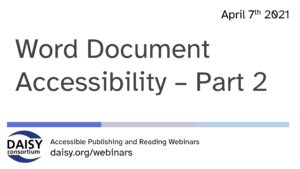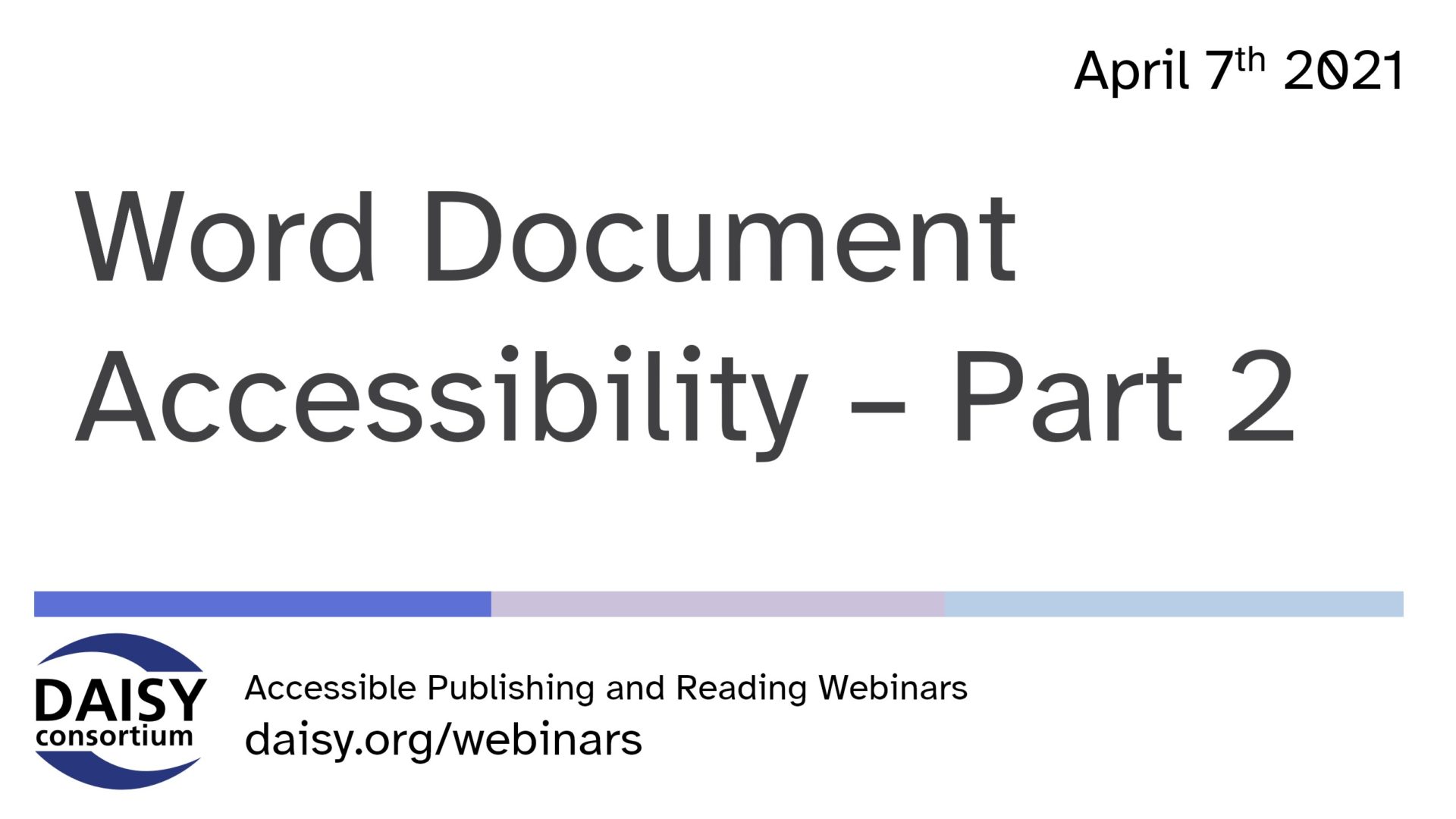Word Document Accessibility Part 2 (W)

In our series of free weekly webinars April 7th saw our second session focused on Word document accessibility – part two to the previous webinar, Word Document Accessibility 101, delivered on March 10th.
This page contains:
Full Video of the Webinar
Speakers
- Erin Williams, Microsoft: host and chair
- Prashant Verma, The DAISY Consortium
- Richard Orme, The DAISY Consortium
Session Overview
Following on from the previous session on word document accessibility which looked at the fundamentals, Erin Williams introduced us to the webinar session and explained that by popular demand, this webinar is back to look at “Beyond the Basics of Word Document Accessibility”.
Richard Orme gave an overview of what can be expected from today’s webinar in this continued discussion. This was an extremely practical webinar, full of demos and practical examples so it is advised to review the recording for the full experience!
Top Tips for Checking Alt Text
Prashant reminded us that in order for a document to be accessible it is crucial that alt text is provided for all the images within that word document. Checking that this in place can be a time-consuming process but we have discovered that you can do this via the search feature:
- Open search with Ctrl F
- enter the search term: ^g
- Cancel the dialogue box
- Use Ctrl PgUp and PgDn to navigate between images
Magically Apply Headings
If there is no heading structure in your document (which is fundamental to navigation and, therefore, accessibility) you can:
- Select one of your “pseudo headings”
- Select your Home tab and the editing area here
- Choose the Select button
- Choose Select All Text With Similar Formatting
- Apply the chosen heading style
You can change the look of the headings if you require but you will have applied a heading structure for each level of headings within the document. Design and structure are separate from each other and, again, this is fully demonstrated within the recording of the webinar presentation.
Use Power Search and Replace to Clean Up
Accessibility of your document can be greatly improved by clearing up the following using the search and replace feature:
- Remove empty headings and paragraphs and use paragraph and line spacing instead which is far more accessible
- Remove extra spaces
- Also, remove Tabs, manual line breaks etc. if you can
By cleaning up the document, using the find and replace tool, navigation and document structure are greatly improved. If more white space is required to make the document more visually appealing then it is suggested that you make use of the para and line spacing features that are provided by Word (rather than manually inserting them). This helps to create a document that is desirable for everyone.
Turning the Tables
Richard Orme looked at how to deal with multiple headings for rows and columns within a table which can often be very challenging in terms of accessibility. Many tables look perfectly fine but Prashant showed us how table features need to be attended to so that screen readers can access information. Many issues have easy fixes – eg. putting the heading of the table above / below / outside the table and not in a row within the table. This eases navigation of the rows and columns for screen readers. It’s so important to think about how a screen reader is going to convey tabular information to a user – simple and straightforward design is essential
Alt Text for tables should be handled specifically – right-click on your table to view table properties including alt text and a table description. As screen readers will read out the contents of your table, the alt text can be used as an option to provide additional useful information for the reader. Likewise, do not rely on the alt text to make an inaccessible table accessible.
Accessible Textboxes
Creating textboxes that work for everyone is vital. If text boxes are created using the regular word feature they are inserted as a floating shape which is inaccessible to assistive technology, making it impossible to determine where they appear in the reading order. There are alternative ways of doing this that do indeed work, by using the borders and shading tools as demonstrated by our presenters.
Charting the Way Forward
Charts present unique challenges to accessibility and it is advisable to consider alternative methods of presentation if at all possible. If a chart is the best way forward then we suggest:
- Convert charts to images so that you can insert alt text or longer descriptions that describe the image.
- Add alt text which is reliable (many screen readers don’t automatically announce alt text in charts so this causes an immediate problem). Very often charts require a much longer description so that numerical data etc. can be conveyed correctly (it may be useful to refer to our webinar on long descriptions and how to manage these).
A practical example using a chart created in MS Excel and then inserted into the word document was shown – a very visual representation of data.
Filenames and Templates
Both of our presenters asked the questions:
- Do Filenames matter? What do filenames have to do with accessibility – they aren’t even part of the document itself. The filename needs to be descriptive so that readers can understand what is inside the file. It is also best not to have any spaces in the filename so that the document can convert easily into other formats – an underline or dash is better here. The MS tool Power Toys has a renaming feature to make this easy for you.
- Are templates a good or bad thing? If templates are tested for a11y they are a good thing. You can make your own templates using the accessibility guides from the Microsoft Office Templates store or you can look for accessible templates: File > New and type “accessible templates” in the Search for online templates box

